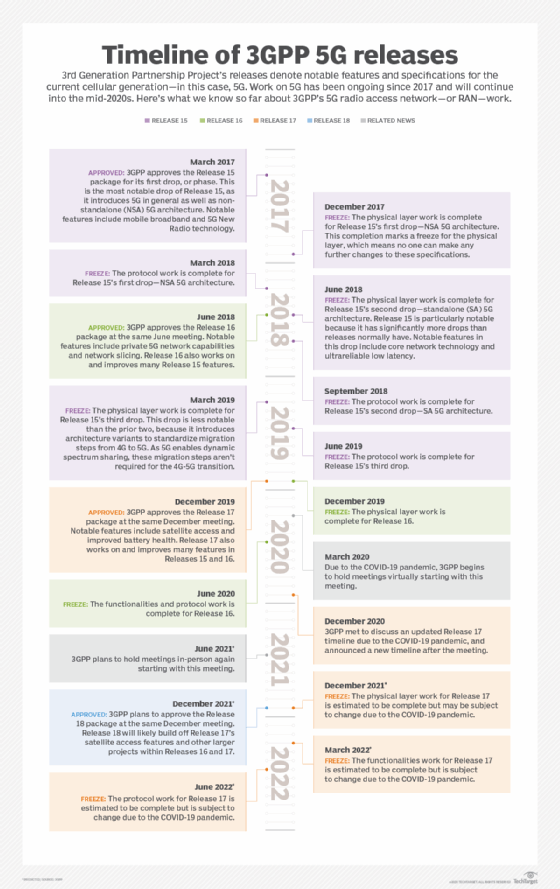
ake78 (3D & photo) - Fotolia
An overview of 3GPP 5G releases and what each one means
3GPP has standardized features and specifications for all cellular technology generations since 3G. Learn about 3GPP's 5G timeline and notable features each 5G release introduces.
While cellular technology has primarily benefited consumer use cases over the years, the 3rd Generation Partnership Project's, or 3GPP's, 5G releases will heavily focus on new capabilities for businesses and enterprises.
3GPP is a conglomerate of telecommunications standards organizations that originally joined together to create global specifications and standards for 3G technology. 3GPP is still active and working to create new releases, which comprise standardized features and specifications developers can use and implement, for 5G technology. The 5G releases, as well as 5G technology in general, are projected to be completed and commercially available quicker than prior cellular generations, said Balazs Bertenyi, 3GPP's radio access network (RAN) chairman.
3GPP meets four times a year at the end of each quarter to plan and develop new releases, which improve upon past releases and provide new standardized functionalities. The four releases already slated for 5G are Releases 15, 16, 17 and 18, although 3GPP may add more as technology and user needs evolve over time.
Take a look at what the existing 3GPP 5G RAN releases timeline looks like and the notable features of each release, as well as how the COVID-19 pandemic has affected 3GPP's timeline in addition to carriers' 5G deployment timelines.
3GPP Release 15
The first drop
Timeline. 3GPP approved the initial package for Release 15 in March 2017 -- the group's first meeting of 2017. Release 15 almost immediately proved it would differ from its predecessors and successors, as it featured three RAN drops, or phases, while most releases have a single drop.
The first drop focused primarily on mobile broadband for non-standalone (NSA) 5G architecture, Bertenyi said. NSA architecture means 5G would require 4G as a base, with 5G on top to boost capacity or network speeds.
The first RAN freeze of Release 15 took place in December 2017. After a freeze, specifications cannot be changed, and the drop is complete. This first freeze completed the physical layer for Release 15's first drop, which Bertenyi said is the first aspect 3GPP completes on the RAN side. The protocol freeze happened three months later in March 2018, following a fairly standard freeze timeline for 3GPP releases.
Notable features. This first drop was significant because it introduced 5G and initial 5G functionalities. It brought the speed and capacity boosts, as well as mobile broadband, which Bertenyi called the "bread and butter" of the cellular technology and sets the scene for more advanced technologies, such as multiple input, multiple output. 5G New Radio technology was also introduced in the first drop, as well as the specifications for 5G NR hardware development.
"From an industry perspective, this was perhaps the most important element of this early drop: It allowed early quirks and development difficulties of New Radio to be worked out," Bertenyi said.
The second drop
Timeline. For the second drop -- which Bertenyi dubbed the "main drop" of Release 15 -- the physical layer freeze occurred in June 2018 and introduced standalone (SA) 5G architecture. Contrary to NSA architecture, SA architecture enables 5G to exist without a 4G base. The protocol work freeze occurred at the September 2018 3GPP meeting.
Notable features. Along with SA 5G architecture came the entire suite of 5G functionality, Bertenyi said, including an integral part of 5G: the core network architecture, which makes SA architecture possible. Another feature of 5G's full suite is ultrareliable low latency, a level of connectivity that enables fast responses and reliable remote communication. Bertenyi called this a "true game changer for 5G."
The third drop
Timeline. The physical layer freeze of Release 15's third and final drop occurred in March 2019, with the protocol freeze following three months later in June 2019. This freeze concluded Release 15. According to technology journalist Dan Jones, this also enabled 5G to be commercially available near the end of 2019, which is when U.S. carriers began to deploy their own 5G technology.
Notable features. The "late drop," as Bertenyi called it, was less notable than Release 15's other two drops because it introduced various architectures that 3GPP standardized to simplify migration from 4G to 5G. Yet, these architectures aren't required for migration, as 5G can use dynamic spectrum sharing (DSS) -- later introduced in Release 16 -- and share spectrum with existing 4G connectivity. As a result, this drop wasn't critical for overall 5G functionality.

3GPP Release 16
Timeline. 3GPP approved the Release 16 package in June 2018. The group typically approves the next release's initial package during the same meeting where they freeze the standard they're currently working on, so 3GPP simultaneously approved the Release 16 package and froze the physical layer work for Release 15's second -- or main -- drop.
Release 16's physical layer freeze occurred in December 2019. The delay from the June 2018 approval to the December 2019 freeze likely resulted from Release 15's multiple drops that required work and attention ahead of Release 16. After that, 3GPP froze the protocol work and functionalities for Release 16 in June 2020.
While 3GPP typically completes the physical layer and protocol work within three months of each other, the COVID-19 pandemic forced the group to meet virtually starting in March 2020, delaying their work on Release 16 and onward.
Notable features. Release 16 continued the previous work on features from Release 15 -- such as mobile broadband -- but also introduced DSS, network slicing and features designed for private 5G networks. Network slicing is a critical part of Release 16, Jones said, because it can enable enterprises to change aspects of their networks over time.
With this release, 5G began to focus intently on enterprise and business applications. Private 5G networks and network slicing capabilities will primarily benefit enterprise use cases rather than consumers and begin to blur the line between strictly cellular and strictly Wi-Fi capabilities, a point both Jones and Bertenyi noted.
"There are many elements of Wi-Fi networks that won't inherently support all those radio capabilities. Because Wi-Fi is nice -- it's relatively cheap, simple to configure, almost off the shelf -- but it's never going to support the ultrareliable low latency, for example, if you need that kind of functionality in your network," Bertenyi said.
3GPP Release 17
Timeline. 3GPP approved the Release 17 package in December 2019 at the same meeting as the freeze for Release 16's physical layer work. So far, COVID-19 has most affected Release 17, as the majority of the work for this release has happened virtually. 3GPP is a global operation, which can further complicate the existing complexity of video conference meetings.
The pandemic delayed Release 17's initial timeline by about six months. 3GPP met in December 2020 to discuss an updated Release 17 timeline and released an official announcement after that meeting, detailing the group's current, projected timeline for Release 17.
The planned dates for Release 17's physical layer, functionalities and protocol work freezes are December 2021, March 2022 and June 2022, respectively. This timeline assumes 3GPP will resume in-person meetings from June 2021 onward, yet is likely subject to change depending on the continued threat of COVID-19.
Notable features. Like Release 16, Release 17 will improve upon features from Releases 15 and 16, including DSS and private 5G network capabilities. Release 17 will also introduce new features, such as improved battery health and satellite access.
Satellite companies have primarily used and struggled with proprietary radio technologies over time, Bertenyi said. With the advent of 5G, many of these companies wanted to adopt 5G NR for their satellite radio technology and made their case successfully to 3GPP.
"With Release 17, we're actually doing the first batch of work for making NR workable for satellite access," Bertenyi said.
3GPP Release 18 and onward
4G took 10 years and six different 3GPP releases to reach the capabilities and functions it ultimately provides, so it's likely that 5G will include multiple releases. After the December 2020 meeting, 3GPP updated its public documented information to include Release 18 as a 5G release.
While the COVID-19 pandemic has delayed Release 18 production, as 3GPP can't meet in person to discuss, debate and determine what Release 18 could look like, the group anticipates in-person meetings will begin again in June 2021. 3GPP's projected timeline expects the group to approve Release 18's initial package in December 2021 -- the same meeting in which the group plans to freeze Release 17's physical layer work.
Still, this all depends on if the group can physically gather again or if they will be forced to continue virtual meetings for the foreseeable future.







